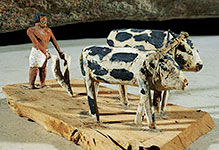
Agriculture
Agriculture

#030102 5
Figure of a man with a hoe, from Assiut, Egypt, 6th Dynasty, c2250 BC. By the Ne...

#03010242
Servant wearing panther skin offering lotus to God Osiris (depicted with flail a...

#03010249
Coptic textile (linen and wool) showing a nilometer. Nereids and putti are depi...

#03030123
Statue of Ashurnasirpal II (883-859 BCE), from Nimrud, northern Iraq. It was pla...

#03030237
Relief of a harvest scene from the mastaba of Ipi. Saqqara, Egypt; Old Kingdom...

#03030266
An Egyptian terracotta figurine showing a man driving an Archimedean screw as a...

#03040146
Scenes from rustic life 1578; Afghanistan, Herat brown ink with heightened bro...

#030503 9
Black-figured "Siana" cup, Greek, 575-550 BCE. Both sides of this cup show activ...

#03050757
Temple of Ceres, Goddess of Agriculture, Paestum. The Doric temple has 34 fluted...

#03060268
Indian nasturtium; stem,leaves and red flowers; seeds in lower right. From "The...

#030703 9
Rice planting during a summer shower. Sheet from the series "60 Famous Places i...

#03070325
Harvesting of rice. Watercolour. China; Yuan dynasty, 13th-14th century CE.
